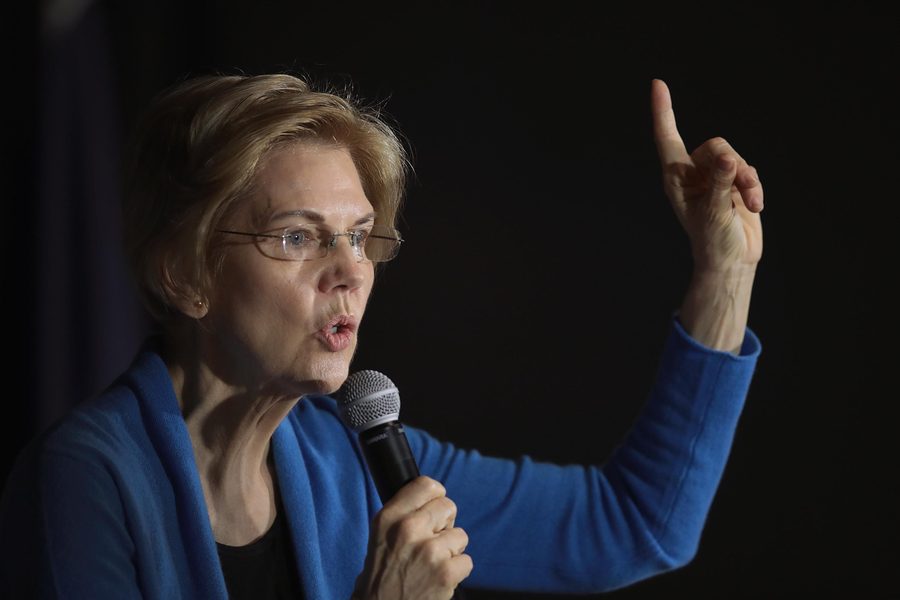Elizabeth Warren’s Universal Child Care Plan Is a Good Start. Other 2020 Candidates Can Up the Ante.
Warren’s plan represents a big step forward, but we should demand something far bolder to address the child care crisis in America.
Kathleen Geier

One of the most outrageous features of American life is our lack of a functional child care system. When it comes to child care, we’re disgracefully behind the rest of the world. The statistics are hair-raising: For two-earner families in the United States, average child care costs are more than twice as high, as a percentage of family income, as they are in many other developed countries in the OECD. For single parent families, these costs are more than four times as high. In 28 states, a year of child care is more expensive than annual tuition at a public college.
Child care represents both a growing crisis and an urgent political priority for two main reasons. The first is that redistributing the burden of caring labor is essential to women’s freedom and autonomy. For nearly 20 years, the labor force participation of American women has been falling. Researchers say that the rising costs of child care and our lack of family-friendly policies are what’s driving the decline.
Second, early childhood education programs are a critical tool in fighting racial and economic inequality. By the time poor kids and nonwhite kids enter the K-12 school system, on average, they are already significantly behind their whiter, wealthier peers. Preschool helps narrow that gap.
But despite the fact that child care is essential to jumpstarting the stalled gender revolution, in recent decades, American feminists have given the subject short shrift. Mainstream feminist organizations have failed to organize around the issue. And how many feminist op-eds have you read about child care, as opposed to other vital feminist concerns such as abortion or sexual assault? After Richard Nixon vetoed a 1971 bill that would have created a national child care system, child care essentially dropped off the political map. Ever since, as a political issue, it’s been deader than disco.
That’s why it’s been so exciting that lately, there’s been an upsurge in public awareness of the issue. Public intellectuals including Katha Pollitt and Matt Bruenig have addressed the issue in recent op-eds and policy reports. And last week, Elizabeth Warren made child care one of her first big policy proposals.
Before analyzing Warren’s plan, it’s important to lay out a vision of what our child care system would look like. Ideally, child care would be:
1. Free
Cost should not be a barrier to care.
2. Universal
All children would be included. There would be enough slots to accommodate everyone and no child would be turned away due to lack of funds. Universality would also mean that kids of all classes would participate in the same child care system. That is a good thing, because when a social program serves not just working people but the rich and the middle class, quality tends to be higher and political support more enduring.
3. Publicly funded by the federal government
Public funding is essential, because as we’ve seen, left to its own devices, the market does a terrible job of providing affordable, accessible care. The federal government should be the entity paying for child care, because in our federalist system if we leave it to state and local governments, funding will be less generous and less equitable. People in conservative parts of the country and in minority and low-income neighborhoods will be screwed.
Also, state and local budgets are more vulnerable to economic downturns, whereas in lean economic times the federal government can borrow money to fund essential services.
4. Publicly provided
Public provision would take the profit motive out of care, where it doesn’t belong, and also provide democratic accountability. Public provision also guarantees that our child care system will be secular and government money won’t go to religious institutions.
5. Accessible
At the height of second-wave feminism in the 1960s and early 1970s, even establishment feminist organizations like NOW were calling for 24/7 child care centers nationwide. In an ideal world, those would exist. And child care centers, like public schools, would be located in every neighborhood, within a walkable distance from your home or easily accessible via public transportation.
6. High-quality
Facilities should be state of the art and staff should be people who truly care about children and are well-trained. The educational components should be high-quality as well.
7. Provided by workers who are well-compensated
Because it’s considered women’s work, child care, like other caring professions, is notoriously underpaid. That needs to change. Child care work needs to be respected and valued and that should be reflected in workers’ paychecks.
8. Organized in a way that promotes racial, gender, and economic equality
This is critical. As advocates have noted, the American child care system is plagued by child care deserts: communities, many of them low-income and predominantly nonwhite, where quality affordable child care is scarce. Any child care proposal worth its salt needs to address these inequities and make quality care accessible in places where it doesn’t currently exist.
In addition, the child care system should not reinforce gender inequities. That’s why we should take a hard pass on plans (such as Matt Bruenig’s otherwise excellent child care proposal) that would pay parents to stay home to take care of their kids on a permanent basis. Such schemes tend to incentivize traditional gender roles instead of abolishing them. As feminist scholar Kathi Weeks argues in her book The Problem with Work, the modern socialist feminist alternative to such plans (and the successor to second-wave feminism’s wages for housework campaigns) is the universal basic income (UBI). A UBI would provide economic support for people who leave the paid labor force to care for their children, but because it’s not tied to care work there’s less of a risk that it would reinscribe gender inequality.
Those eight components are the ideal, though the kind of system I’ve outlined likely doesn’t exist anywhere in the world right now. Even in the Nordic countries that many of us on the Left would like to emulate, child care is not free. It’s far more affordable, but parents are charged fees or sliding scale payments.
Right now, the child care system in the United States is a spectacular failure on all eight of those criteria. Perhaps the best you can say is that there’s nowhere to go but up.
Certainly, compared to the status quo, Warren’s plan is a giant step forward. Unfortunately, it doesn’t go nearly as far as it should. It would certainly move us closer to all eight of my desired criteria, but for a progressive Democrat running in 2020 we should expect — and demand — something much bolder.
The problem is not so much that Warren’s plan isn’t free. No one was expecting that and to its credit, the proposal would go a long way to making child care more affordable. No family would spend more than 7 percent of their income on child care and families earning under 200 percent of the poverty line wouldn’t have to pay anything at all. The subsidies would also apparently go directly to the provider — none of that complicated tax credit nonsense that was the main feature of Hillary Clinton’s child care plan.
Other features of Warren’s proposal include provisions to increase the pay of child care workers and “invest in” their training. But raising the licensing and accreditation standards for child care workers creates potential pitfalls, especially if it means forcing them to get expensive college and perhaps unnecessary degrees. There aren’t enough early childhood and education programs in public colleges to meet demand, which forces child care workers to get their degrees from rapacious for-profit colleges and piling up mountains of debt in the process. And even after receiving a degree, their wages are still extremely low.
The biggest disappointment, though, is that there’s not more in the proposal about creating public provided care. Yes, there is something: Warren proposes creating a network of “Child Care and Early Learning Centers and Family Child Care Homes.” But those centers and homes would not necessarily be run by state or local governments and at least some would be contracted to nonprofit groups, including “faith-based organizations.” That federal dollars will be going to religious institutions raises some concerns. How can we ensure public money will not be used for religious proselytizing?
But the role of religious institutions in Warren’s plan is a minor problem compared to the elephant in the room: the plan’s lack of a robust infrastructure for publicly provided care. Her plan will create increased demand for care but doesn’t do nearly enough to ensure that there are enough providers, particularly in underserved areas. And if the people who need child care most can’t access it, how universal is her plan, really?
That said, Warren’s proposal compares favorably to those of the rest of the presidential field. As yet, none of the other candidates have announced a major child care proposal, though a number of them — Warren, Kamala Harris, Cory Booker, Bernie Sanders, Kirsten Gillibrand and Amy Klobuchar — have co-sponsored a less sweeping bill that would expand access to child care for low- and middle-income families. In addition, Gillibrand and Klobuchar have co-sponsored legislation to expand the child care tax credit. Bernie Sanders ran on universal child care in 2016 but never released a detailed proposal. In 2011 he introduced an early childhood education bill, but that plan didn’t go as far as Warren’s.
Warren’s program would establish the principle that the U.S. government should play a far more sweeping role in creating affordable, accessible child care. To that end, it’s potentially one of those non-reformist reforms that eventually get us to the place where we should be. As such it should be welcomed, even though at this point we have a right to demand far more. Hopefully the other 2020 candidates will step up and raise the ante.







